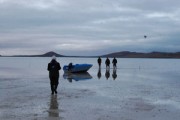4 June 2010: The UN Development Programme (UNDP) and the Hazar Nature Reserve, located on the Caspian Sea Coast of Turkmenistan, are developing adaptive approaches to promote the conservation of biodiversity in the reserve.
The project, implemented in collaboration with the Global Environment Facility (GEF) and the Ministry of Nature Protection of Turkmenistan, aims to […]
 4 June 2010: The UN Development Programme (UNDP) and the Hazar Nature Reserve, located on the Caspian Sea Coast of Turkmenistan, are developing adaptive approaches to promote the conservation of biodiversity in the reserve. The project, implemented in collaboration with the Global Environment Facility (GEF) and the Ministry of Nature Protection of Turkmenistan, aims to predict and map the effects of climate change, including rapid change of the shoreline, the emergence of new islands, the disappearance of existing landscapes, and biodiversity loss.
4 June 2010: The UN Development Programme (UNDP) and the Hazar Nature Reserve, located on the Caspian Sea Coast of Turkmenistan, are developing adaptive approaches to promote the conservation of biodiversity in the reserve. The project, implemented in collaboration with the Global Environment Facility (GEF) and the Ministry of Nature Protection of Turkmenistan, aims to predict and map the effects of climate change, including rapid change of the shoreline, the emergence of new islands, the disappearance of existing landscapes, and biodiversity loss.
The project will also propose ways to mitigate climate-related impacts such as developing biodiversity protection priorities for the reserve, establishing a conservation regime, mapping out ecological guided tours to promote biodiversity in the reserve, and assisting local and national authorities to plan housing construction in the coastal zone of the Caspian region. The Hazar Nature Reserve, predominantly a wetland, is home to over 1800 species of flora and fauna, which are mostly endemic to the region. The reserve is a major stopover point for migratory birds, including the Central Asian-Indian Flyway and the East African Flyway. The receding sea levels may cause intertidal islands to disappear along with birds’ nesting sites and other wildlife. Based on current studies in the reserve, researchers have developed recommendations for the conservation and sustainable use of biological resources. [UNDP Press Release]